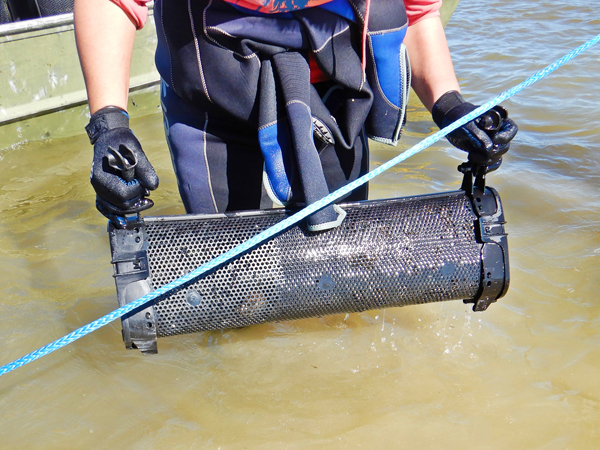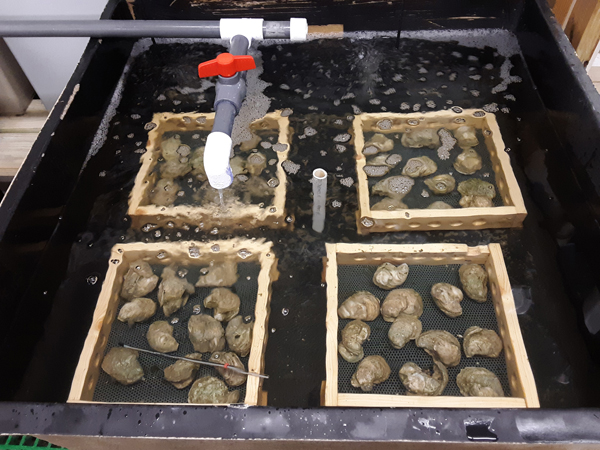- La Feria Native Soon To Retire From The Military This Summer
- Senior Eneece Avila Takes Pride in her State Title
- Dr. Noemi Infante, Harlingen Medical Center Open New Women’s Clinic
- Santa Rosa Cameron County Park Partially Reopens
- Santa Rosa Takes to Regionals Meet in Kingsville, Tx
- Long-Standing Nexstar Tower in La Feria Decommissioned
- Lionettes Powerlifting Meet
- Local Business Holds Event to Benefit RGV Shriners Club
- Knights of Columbus Holds it’s 30th Annual Golf Tournament
- KGBT Tower Dismantled
Legislation, Science Bode Well for Future of Oyster Aquaculture in Texas
- Updated: August 9, 2019
Texas A&M AgriLife Research instrumental in ‘spawning’ new coastal industry

Setting an oyster cage in place. Legislation and science have opened the door for a new oyster aquaculture industry along the Texas Gulf Coast. Photo: Texas A&M AgriLife Research
CORPUS CHRISTI – At the intersection of legislation and science, a new opportunity for an ecologically and economically sustainable oyster aquaculture industry is being spawned on the Texas Gulf Coast.
For years, Dr. Joe Fox, a Texas A&M AgriLife Research scientist with a joint appointment at Texas A&M University-Corpus Christi through the Harte Research Institute, HRI, has been at the center of the oyster aquaculture effort. His involvement has ranged from working with legislative and business leaders to helping draft legislation to investigating different types of oyster cages for use in aquaculture.
“Due to overfishing, excessive freshwater inflow and loss of infrastructure mainly due to hurricanes, Texas oyster harvests have been trending downward and have experienced a 43% loss in the past three to four years,” Fox said. “Oyster aquaculture is a $200 million-plus industry in the U.S. and currently exceeds fishing yields, but Texas was the last coastal state in the nation to allow commercial oyster aquaculture.”
The Texas legislature recently made commercial oyster aquaculture a real possibility for Texas by passing two bills during its most recent legislative session, Fox said. He cited House Bill 1300 sponsored by Reps. Todd Hunter, Genie Morrison, Dade Phelan, Eddie Lucio and John Cyrier, and Senate Bill 682 sponsored by Sen. Lois Kolkhorst and co-sponsored by Sen. Gina Hinojosa.
“Both bills were strongly supported by Coastal Conservation Association and the Texas Restaurant Association and passed their respective chambers virtually uncontested,” he noted.
The bills will become law on Sept. 1, at which time Texas Parks and Wildlife Department rules and regulations relating to oyster aquaculture will be developed, Fox said. Actual aquaculture production is expected to begin around September 2020.
Fox has received $6.6 million in funding to establish the Oyster Resource and Recovery Center in Palacios for aquaculture, reef restoration and outreach and education starting this fall. He also received $750,000 in funding from the National Oceanic and Atmospheric Administration through the TPWD as part of Texas’ Disaster Relief Funding to establish an oyster farming evaluation project in Matagorda Bay, also slated to begin this fall.

Oysters being conditioned for spawning at the Texas A&M AgriLife Research Mariculture Laboratory in Flour Bluff. (Texas A&M AgriLife Research photo)
Another effort Fox was involved with was a recent study led by Dr. Hugo Magaña, an AgriLife Research associate research scientist at the Texas A&M AgriLife Research Mariculture Laboratory in Corpus Christi. Magaña recently made the first attempt to spawn oysters in a laboratory setting in more than 27 years.
“The ability to emulate the natural spawning of local oysters in a laboratory setting bodes well for Texas oyster mariculture,” Magaña said. “That way there will be no need to collect oysters every year to produce larvae. And these oysters can be retained over their lifespan and produce year after year, providing us oysters with known genetic traits.”
Magaña said in late March about 200 adult oysters from Copano Bay near Corpus Christi were brought to the AgriLife Research facility in Flour Bluff. Another 500 or so adult oysters were brought in on June 14 to increase the “broodstock” supply.
Male oysters were examined bi-weekly to ascertain their spawning condition. Oysters deemed to be at peak maturation were placed on a spawning table and water was heated to about 86 degrees. Male and female oysters were placed in separate containers to collect genetic material.
“Flow was commenced, and within 15 minutes a male oyster began to release his genetic material, inducing other oysters to follow suit,” Magaña said. “The genetic material from the male and female oysters was mixed together and within minutes the fertilized oyster eggs began cell division. Within an hour blastula, or multiple cells, were present, and within several more hours trochophores had developed and were then considered free-swimming larvae.”
The larvae were deposited into tanks filled with filtered seawater and provided with aeration and algae. On the fourth day, they were emptied to be evaluated and enumerated.
“Another benefit of spawning oysters in a lab setting is that we can provide seed oysters to commercial aquaculturists all year long and have a dependable source for producing oysters for restoration,” he said.
Fox said Magaña will be continuing the research in Flour Bluff to spawn oysters and produce juvenile or ‘seed’ oysters for cage-farming research.

Oyster reefs provide a variety of ecological benefits to the Texas Gulf Coast. (Texas A&M AgriLife Extension Service photo
“Some additional steps toward making oyster aquaculture a reality for the Texas Gulf Coast include submitting one proposal to the Texas Sea Grant for oyster hatchery training and another to develop models to identify the best potential sites for oyster aquaculture along the coast,” he said.
Dr. Larry McKinney, HRI senior executive director at Texas A&M University-Corpus Christi, said while the new laws will pave the way for the development of oyster aquaculture in Texas, other gulf states such as Alabama, Louisiana and Florida already have a significant head start.
“The development of a viable and competitive oyster aquaculture industry will not only create jobs and economic growth for the beleaguered Texas coast, it will also provide supplemental benefits,” McKinney said. “Oyster reefs provide tremendous ecosystem services to humans by recycling nutrients, cleaning the water, protecting shorelines against storm surge and erosion, and in terms of carbon sequestration.”
Even in cages, oysters can perform many of these services and most importantly, reduce pressure on our natural reefs.”
He also noted Texas is well-positioned to launch the oyster aquaculture industry because of its healthy coastal ecosystem and miles of coastline.
“Done properly, oyster aquaculture will help us fulfill our mission to balance a healthy Gulf of Mexico with a healthy coastal economy,” he said. “We can grow this industry if we all work together to ensure it is both economically and environmentally sustainable.”






